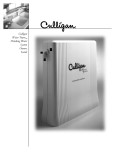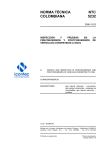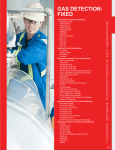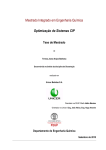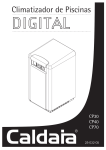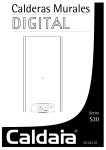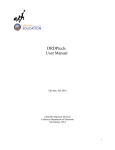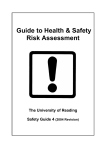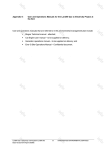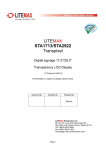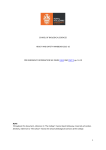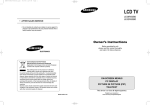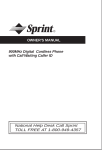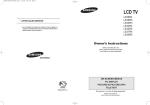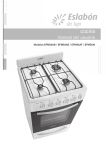Download UK FRS HazMat guidance section on gases
Transcript
PART C–5 UN Class 2 Gases (including acetylene) General information Introduction 7C5.1 This section offers Fire and Rescue Service staff technical operational guidance to assist them in carrying out operational risk assessments to safely resolve emergency incidents involving gases. It does not cover the basic scientific principles applicable to gases, such as the gas laws, as these are contained in Fire Service Manual (volume 1 Fire Service Technology, Equipment and Media) Physics and Chemistry for Firefighters. Characteristics and classification What are gases? 7C5.2 Gas is one of three states of matter. Dependant on pressure, most substances can be cooled to form a solid. As heat is added to the solid it turns into a liquid at its melting point, and then changes into a gas at its boiling point. 7C5.3 A pure gas may be made up of individual atoms (eg a noble gas or atomic gas like neon), elemental molecules made from one type of atom (eg oxygen), or compound molecules made from a variety of atoms (eg carbon dioxide). A gas mixture would contain a variety of pure gases much like air. 7C5.4 Vapour refers to a gas phase at a temperature where the same substance can also exist in the liquid or solid state, below the critical temperature of the substance. 7C5.5 Gases and vapours have no size or volume; they expand to fill their container or in the open spread out until they are equally distributed throughout the space available to them. The physical behaviour of gases is described by the gas laws. Properties, notable for those who have to manage incidents, include: • gases and vapours exert an increasing pressure on their containers as they are heated • when a gas or vapour expands, perhaps as it escapes its container, its temperature falls. Technical considerations 295 UN Class 2 – classification 7C5.6 Gases are recognised by their containers, warning symbols and their behaviour. 7C5.7 In the system of hazard classification devised by the United Nations SubCommittee of Experts on the Transport of Dangerous Goods (UNSCETDG) the following classes are directly associated with gases: • Class 2.1 – Flammable gases • Class 2.2 – Non-flammable, non-toxic gases • Class 2.3 – Toxic gases • Class 4.3 – Substances which in contact with water emit flammable gases 296 Fire and Rescue Service Operational Guidance – Incidents involving hazardous materials 7C5.8 With regard to compressed gases, primary identification is by means of the shoulder label with the name and chemical formula, an example of which is shown below. Technical considerations 297 7C5.9 Secondary identification is by cylinder shoulder colour. Unless otherwise specified, gas and gas mixtures can be identified by a colour classification indicating gas properties in accordance with the risk diamond on the cylinder label, for example: 7C5.10 A number of the most common gases have been assigned a specific colour. The specific colours assigned to the common gases are shown below. The full scheme is contained in BS EN 1089-3: 1997, which although not mandatory by law is being adopted by British Compressed Gas Association member companies. Fire and Rescue Service responders should be aware that body colours below the shoulder of a cylinder are not specified and may vary according to the gas company. The adoption of BS EN 1089-3: 1997 has been agreed by the British Compressed Gas Association and the Health and Safety Executive and is expected to be in adopted in 2015. 298 Fire and Rescue Service Operational Guidance – Incidents involving hazardous materials Cylinder identification marks 7C5.11 There are stamp markings on the cylinder shoulder, which may also help to identify the contents of a cylinder and the owner. Typical markings on cylinder necks are shown below. The name of the industrial gas company will be stamped on the cylinder. This will allow identification of the cylinder owner is. For acetylene cylinders, the word acetylene is stamped onto the neck. Technical considerations 299 Hazards Compressed gases 7C5.12 Compressed gases pose different hazards to chemical liquids or solids and can often be more dangerous due to the following hazards: • potential source of high energy, particularly in high pressure cylinders • cylinders containing compressed gases may fail if over-pressurised or weakened by the application of heat • low boiling point of some liquid contents resulting in the potential for ‘vapour flashing’ • ease of diffusion of escaping gas • leakage of flammable and/or toxic gases can cause dangerous conditions especially if they are confined • low flashpoint of some highly flammable liquids • absence of visual and/or odour detection of some leaking materials • heavy and bulky containers, unless cylinders are secured they may topple over, cause injuries, become damaged themselves and cause contents to leak • if the regulator and valve assembly shears off, the cylinder may ‘rocket’, like a projectile or ‘torpedo’, dangerously around the workplace • liquefied gases (eg butane, propane etc) respond more rapidly to heat than the permanent gases such as nitrogen or oxygen • low boiling point materials can cause frostbite on contact with human tissue • some cylinders are protected by pressure relief valves, fusible plugs or bursting discs, however, these may not work correctly in a fire situation, or if damaged • other physical hazards stem from the high pressure of a cylinder’s contents (eg accidental application of a compressed gas or jet into eyes or onto an open wound, whereby the gas can enter the tissue or bloodstream, is particularly dangerous). 7C5.13 To prevent the interchange of fittings between gases, cylinder valve outlets are left hand threaded on flammable gas cylinders and right hand on other gases. Cylinders in fires 7C5.14 300 All cylinders represent a potential hazard if directly involved in a fire. Cylinders are pressure vessels, designed to withstand high internal pressure but if that pressure increases with heat they may fail. This is particularly important if Fire and Rescue Service Operational Guidance – Incidents involving hazardous materials cylinders are directly impinged with flame as, in addition to the increase in internal pressure, the cylinder shell itself starts to lose its strength as a result of excessive heat. 7C5.15 The nature of the failure and its consequences depends on the combination of cylinder design and gas type. Flammable gases clearly represent a greater risk but all failures will have significant consequences. Flammable gases 7C5.16 Failure of flammable gas cylinders result in the release of combustion energy if they burst in a fire. Hazards from this include: • a blast pressure wave • fireball • cylinder fragments may be thrown considerable distances • flying fragments may travel up to 200 metres and have high looping trajectories • flying glass and other structural material • structural damage to buildings in the vicinity. 7C5.17 Flammable gases ignite or burn producing heat and light, and in certain conditions explosions. The following terms should be understood in order to assess the risk posed by this hazard: • Lower explosive, or flammable, limit – lowest concentration of vapour/gas in air at a given pressure and temperature that will propagate a flame when exposed to an ignition source • Upper explosive, or flammable, limit – maximum concentration of vapour/ gas in air at a given pressure and temperature in which a flame can be propagated • Flammable range – concentrations of flammable gas/vapour between the lower and upper explosive, or flammable, limit at a given temperature • Flash point – lowest temperature required to raise the vapour pressure of a liquid such that vapour concentration in air near the surface of the liquid is within the flammable range, and as such the air/vapour mixture will ignite in the presence of a suitable ignition source, usually a flame • Fire point – minimum temperature at which a mixture of gas/vapour and air continues to burn in an open container when ignited • Auto-Ignition temperature – minimum temperature required to initiate or cause self-sustained combustion of material in the absence of any external source of ignition Technical considerations 301 • Critical temperature – that temperature above which no amount of pressure can liquefy a gas. It does not relate to flammability or likelihood of explosion. 7C5.18 Most gases are denser than air, although common exceptions include acetylene, ammonia, helium, hydrogen and methane. Even these may, on escape, be cooler than ambient air and therefore slump initially, but eventually the gas will rise. Gases that are lighter than air may accumulate under structures at high levels unless ventilated. Hydrogen and acetylene, which have very wide flammable limits, can form explosive atmospheres in this way. More dense gases will on discharge accumulate at low levels and may, if flammable, travel a considerable distance to a remote ignition source. Toxic gases 7C5.19 Toxic or poisonous gases cause harm when we are exposed to them. Generally exposure occurs through inhalation but gases may also be absorbed through the skin. Further information on toxicity is contained in Section 7 Part C-9 – Toxic and infectious substances. Cryogenics (extreme cold) 7C5.20 Cryogenic liquids present a cold burn hazard when they are released quickly, 7C5.124 – Cryogenics for further information. Usage, transportation, packaging and storage Usage 7C5.21 Most industrial gases are naturally occurring and are extracted from the atmosphere. It is not possible or necessary to describe the usage of gases further in this chapter, however, the following chapters contain information on the hazardous materials gases most frequently encountered by firefighters at emergency incidents. Transportation and packaging General 7C5.22 302 The transportation of gases as gases at ordinary temperatures and pressures is not a practical or economically viable option for the chemical industry due to the size of containers that would be required. Viable storage and transport options Fire and Rescue Service Operational Guidance – Incidents involving hazardous materials rely on cooling, the application of pressure and dissolving gases. The favoured option is to use pressure to liquefy a gas but for every gas there is a critical temperature above which it cannot be liquefied by the application of pressure. 7C5.23 Gases below their critical temperatures are often called vapours and can be liquefied by the application of pressure so as to be transported or stored as liquids at ambient temperature. Above this critical temperature gases can not be liquefied by the application of pressure alone. When a pressurised liquid is warmed it will exert the critical pressure on its container at the critical temperature. Critical temperatures of common gases Name 7C5.24 Critical temperature (°C) Critical pressure (bar) Boiling point (°C) Ammonia 132 112.8 -33 Butane 152 38 -1 Chlorine 144 77 -34 Propane 97 97 -42 Sulphur dioxide 158 79 -10 Argon -122 49 -186 Oxygen -119 49.6 -183 Nitrogen -147 34 -196 Hydrogen -240 13 -252 Helium -268 2.3 -269 Gases which have a critical temperature below ambient temperature can be stored or transported in small quantities as compressed gases at ambient temperatures but when bulk quantities are required they are usually cooled to just above their boiling point and transported as a refrigerated or cryogenic liquid. NOTE: • Carbon dioxide – can be encountered as solid, liquid or gas. The critical temperature of CO2 is a little over 31°C so for most of the year when encountered in small quantities (as in the case of fire extinguishers) it will be a pressurised liquid but on a hot day it will be a gas. Small quantities of carbon dioxide can also be encountered as a solid used as a refrigerant called ‘dry ice’, which does not melt but turns into a gas as it warms up. This process by which a solid does not melt but turns directly into a gas as it warms is known as ‘sublimation’. Bulk carbon dioxide is transported as a refrigerated pressurised liquid. Technical considerations 303 • Acetylene – is different from other gases in that it can decompose in the absence of air into its constituent elements, carbon and hydrogen. This is an exothermic reaction, that is, it gives off heat and is more generally known as decomposition. Exothermic decomposition does not produce as much heat as acetylene burning in air. Decomposition requires a significant input of energy from direct flame contact on a cylinder to initiate it. Mechanical shock alone to a cold cylinder cannot initiate decomposition. Road 7C5.25 Appropriate options for storing and transporting gases are detailed in the European Agreement concerning the International Carriage of Dangerous Goods by Road (ADR), which is enacted into UK law by the carriage of dangerous goods regulations. 7C5.26 In this system a hazard identification number consists of two or three figures, where ‘2’, for example, indicates a hazard of emissions of gas due to pressure or to chemical reaction. Examples of hazard warning numbers associated with a gas hazard Hazard warning number 304 Hazard description 20 Asphyxiant gas or gas with no subsidiary risk 22 Refrigerated liquefied gas, asphyxiant 223 Refrigerated liquefied gas, flammable 225 Refrigerated liquefied gas, oxidising (fire intensifying) 238 Gas, flammable corrosive 239 Flammable gas, which can spontaneously lead to violent reaction 25 Oxidising (fire-intensifying) gas 268 Toxic gas, corrosive X323 Flammable liquid which reacts dangerously with water, emitting flammable gases 323 Flammable liquid which reacts with water, emitting flammable gases 362 Flammable liquid, toxic, which reacts dangerously with water, emitting flammable gases X362 Flammable liquid, toxic, which reacts dangerously with water, emitting flammable gases 382 Flammable liquid, corrosive, which reacts with water, emitting flammable gases Fire and Rescue Service Operational Guidance – Incidents involving hazardous materials Examples of hazard warning numbers associated with a gas hazard Hazard warning number 7C5.27 Hazard description X382 Flammable liquid, corrosive, which reacts dangerously with water, emitting flammable gases 423 Solid which reacts with water, emitting flammable gases X423 Flammable solid which reacts dangerously with water, emitting flammable gases 462 Toxic solid which reacts with water, emitting flammable gases X462 Solid which reacts dangerously with water, emitting toxic gases 482 Corrosive solid which reacts with water, emitting corrosive gases X482 Solid which reacts dangerously with water, emitting corrosive gases Further information on the transportation of gases is contained in Section 7 Part C-3, Transportation, packaging and storage of hazardous materials. Storage 7C5.28 Gases are stored in cylinders, cryogenic vessels or tanks. On-site generation of gas is also an option. Cylinders 7C5.29 Gases are stored in cylinders either as a compressed or liquefied gas, or dissolved in a solvent (eg acetylene dissolved in acetone). Cylinders are subject to rigorous type testing to ensure that they are fit for purpose, and are tested to 1½ times their working pressure. Some cylinders are equipped with safety devices, which are designed to relieve pressure by venting gas as the cylinder heats up. 7C5.30 Serious accidents can result from ignorance of the properties of the gases, or from misuse or abuse. Great care is needed during the transportation, handling, storage and disposal of such cylinders. 7C5.31 Cylinders exist in the following types of construction: • Welded cylinders – two steel halves welded together around the centre • Drawn steel – a single steel skin containing no weld Technical considerations 305 • Aluminium cylinders – lighter in weight than steel cylinders and are used to contain specialist gases • Composite cylinders – a woven jacket impregnated with resin and protected by a hardened plastic outer cage. This type of cylinder is mainly used for liquefied petroleum gas but can be found with various contents. Occasionally these cylinders can have an aluminium lining. 7C5.32 The cylinder construction provides little to no indication as to the contents of the cylinder, but may alter the actions required to deal with them when involved in fire, in particular composite cylinders. 7C5.33 All cylinders may fail in a fire situation and the effect of the consequent explosion will depend upon the nature of the gas contained. Acetylene is a special case because it can undergo a self-sustaining internal decomposition reaction, producing heat, which may continue after the fire has been extinguished. 7C5.34 Liquefied gases are generally of two types: • high pressure (eg carbon dioxide, ethane) • low pressure (eg liquefied petroleum gas). 7C5.35 As the cylinder heats up in the fire, the liquefied gas absorbs some of the heat and boils, increasing the pressure in the cylinder. This will normally result in the operation of a safety relief device, fitted to the cylinder valve, which relieves the excess gas pressure. If the cylinder wall becomes excessively heated, the effective maximum working pressure of it is reduced and the cylinder may fail catastrophically. 7C5.36 Liquefied petroleum gas cylinders failing under heat may result in a boiling liquid expanding vapour explosion. This is where the boiling liquid in the cylinder rapidly vaporises and expands explosively bursting the cylinder. If the gas released contacts a source of ignition this could result in a fireball. Further information is contained later in this Part at 7C5.116, Liquefied petroleum gas. 306 Fire and Rescue Service Operational Guidance – Incidents involving hazardous materials Operational key principle Cylinder Failure – All pressurised cylinders, regardless of their contents are at the greatest risk of failure whilst being subjected to direct flame contact. As a metal cylinder is heated the shell will begin to lose its tensile strength, in composite cylinders heating will also break down the resin. (NOTE: Although steel loses approximately 50 per cent of its strength at about 550°C, rising gas pressure may overcome reducing steel tensile strength at about 300°C) All cylinders ultimately fail because the shell reaches a point where its tensile strength weakens to such a degree (or in the case of composite cylinders the resin breaks down) that it can no longer contain the internal pressure being exerted by the gas. Operational considerations (compressed gas cylinder incidents) Pre-planning 7C5.37 Fire and Rescue Services should ensure that they: • proactively collect information on the location and type of hazardous gases in their turn-out area • make significant information available to mobilising controls and operational staff • have liaison and contact arrangements in place to deal with emergencies involving gas cylinders via the British Compressed Gas Association Competent Person Scheme • have operational plans, which include safe rendezvous points, for significant site-specific risks • review and update any information held. Phase 1: Mobilising and en-route 7C5.38 Consideration: • Pre-planning information should be readily available en-route in an easy to read and understandable format (eg gas cylinders involved in fire – key actions aide memoir, contingency plans, response plans, risk cards, site specific risk plans etc). Technical considerations 307 Phase 2: Arriving and gathering information 7C5.39 Considerations: • Response vehicles must be parked outside any potential blast zone whenever cylinders are suspected of being involved in fire • The Incident Commander should assess any immediate crew and public life risks, then gather information to establish an initial cordon around the potential hazard zone. Consideration should be given to evacuation of the public and non-essential responders. Liaison with the police will be necessary if evacuation is required. Where evacuation is not possible, or is considered inappropriate, all those remaining in the hazard zone should be warned of the risks and, if necessary, advised to stay away from openings especially windows and occupy rooms furthest away from the risk • Staff required to carry out tasks within the initial cordon should make use of all available substantial shielding. Personal protective equipment (personal protective equipment) appropriate to the immediate hazard should be worn, such structural firefighting kit including gloves, flash/fire hoods and eye protection. Staff who are tasked to work behind shielding within the area of the hazard zone likely to be affected by a fireball (ie approximately 25m for a single cylinder) should wear breathing apparatus in addition to the above personal protective equipment • The key information required is: –– Are there cylinders at the incident? and if there are –– Are the cylinders involved in fire? (ie direct flame contact, fire damage or radiated heat damage from the fire) –– Are any cylinders leaking, venting, bulging or steaming? –– What gases are involved? NOTE: If acetylene cylinders are involved and are suspected of having been affected by heat they can pose significant additional risks, these are detailed in 7C5.48. • Other considerations when designating the initial cordon include: –– size of cylinder(s) –– number of cylinders –– shielding provided by any buildings or structures –– type and extent of adjacent structures –– local topography (eg protection provided by slopes and gradients of ground levels etc) –– affect of the potential blast pressure wave 308 Fire and Rescue Service Operational Guidance – Incidents involving hazardous materials –– affect of the potential fireball –– cylinder may be thrown some distance when not contained within the structure or building which would provide substantial shielding –– cylinder fragments and other projectiles (eg valve assembly) may be thrown a considerable distance and have high looping trajectories –– flying glass and other structural material –– structural damage to buildings in the vicinity –– possible need for an exclusion zone within the hazard zone –– other hazards inside or close to the initial cordon –– proximity and importance of adjacent occupancies and key infrastructure, such as major roads and railways. • If cylinders, including acetylene, have not been heated then they do not represent a hazard and should be handed over to the site operator. In a developing fire situation consider carefully moving them if there is a risk that the fire will spread and involve them • Acetylene cylinder identification: –– It should be easy to distinguish between liquefied petroleum gas and other cylinders (including acetylene) on the basis of their shape (see photo of liquefied petroleum gas cylinders below right, acetylene below left). –– To distinguish positively between acetylene and other non-liquefied petroleum gas cylinders is more difficult when they have been subjected to a fire. NOTE: If in doubt, treat the cylinder as though it is an acetylene cylinder, until a positive identification can be made. Technical considerations 309 When cylinders are not affected by fire they can be identified by their label, colour (acetylene cylinders are maroon) or by their markings. In addition the cylinder industry now marks Acetylene cylinders with tape or a plastic collar . Absence of these does not indicate that it is not acetylene. NOTE: Due to the possibility of foreign acetylene cylinders being imported into the UK, it is essential that operational staff called to deal with an incident involving cylinders carry out a risk assessment and consider the possibility of incorrect colour markings. The Incident Commander should use as many sources of information as possible to verify that the contents of the cylinder match the colour coding. These may include confirmation with the owner, occupier or operative; any documentation available; 7(2) (d) information; visual information for example a cylinder connected to an oxygen cylinder or strapped to a welding trolley etc If there is any doubt as to the identification of the cylinder and the risk assessment indicates that there is a possibility that acetylene may be involved, the cylinders should be treated as acetylene until otherwise confirmed. –– Contact the cylinder owner by telephone for specialist advice. Consider asking for the attendance of a specialist at the scene, although there has to be good visibility for this to be productive (gas cylinder supplier contact details are contained below in Phase 3: Planning the response. • If non-acetylene cylinders have been heated but not damaged, they should be cooled, or allowed to cool then handed-over to the site operator who should be fully advised of the circumstances. In a developing fire situation consider cooling and carefully moving them if there is an imminent risk that the fire will spread and involve them • Does the cylinder show signs of heat damage or direct flame contact? –– Check to see whether there is any obvious fire damage to any structure or material near to the cylinders. –– Do the cylinders appear to be scorched? –– Are the labels burnt? –– Are the plastic guard or test rings melted? –– Is the cylinder paintwork burnt or blistered? –– Does the cylinder surface steam or dry out quickly when water is applied? –– Have eye witnesses seen flame impingement etc? –– Is there any visible bulge in the cylinder? –– Are pressure relief devices operating? NOTE: The operation of a pressure relief disc or fusible plug through a fire situation indicates an increased likelihood of catastrophic failure and should not be regarded as a sign of safety. 310 Fire and Rescue Service Operational Guidance – Incidents involving hazardous materials Operational key principle • As cylinders heat up in a fire the pressure inside them increases. Direct flame contact may also weaken the cylinder wall. If heat continues to be applied then the maximum safe working pressure of the cylinder may be exceeded. This may eventually cause the cylinder to burst or fail in a violent manner resulting in the release of a considerable amount of energy. Subsequent events will depend upon the gas type. For inert gases no further action is required. Cylinders containing oxidant, toxic or flammable gases may produce other hazards and specialist advice should be sought from a hazardous materials adviser and/or the gas supplier. For example, flammable gases such as hydrogen or methane will rapidly expand explosively following the cylinder rupture because of the very high internal pressure. This could actually extinguish the fire by blasting it out but also could result in a delayed ignition of the unconfined gas cloud. • Cylinder cooling – As soon as a cylinder is discovered at a fire, regardless of the contents, the Incident Commander should make every effort to extinguish any fire affecting the cylinder and apply cooling sprays directly on to any affected cylinders. • It is important to quickly cool cylinders with water if they have been heated in a fire. This applies to cylinders suffering direct flame contact and also to those affected by radiant heat. • Firefighters carrying out this task should continually risk assess the situation and take advantage of all available substantial shielding/cover. They should consider using ground monitors and lashed jets where severe or prolonged heating has taken place and should always wear appropriate personal protective equipment. NOTE: If firefighters encounter cylinders that have been fully involved in a severe fire for an unknown period of time they should treat them with extreme caution and adopt defensive tactics. • Initial crews discovering cylinders should make every effort, without exposing themselves to unnecessary risk, to identify the type, contents, location and number of any cylinders involved as this will determine the appropriate course of action. In particular, crews should attempt to identify if cylinders are acetylene • Where a cylinder is alight at the valve group, it should be ascertained whether or not it is alight around the cylinder neck (from the base of the valve group where it enters the cylinder) or from where the hoses attach to the valve group itself. A risk assessment needs to be carried out to identify whether Technical considerations 311 the cylinder can be safely turned off. Where the cylinder is alight at the neck (ie the base of the valve group) this indicates that the valve group or cylinder neck is damaged and potentially will not be able to be shut off • In most cases, non-acetylene cylinders which have not failed can be made safe by the application of cooling water. Internal pressure will be reduced as heat is removed from the cylinder and a heat or pressure weakened cylinder shell will recover most or all of its original strength as it is cooled. Once water has been applied and the cylinder wall temperature reduced, the cylinder is very unlikely to fail. Consideration should then be given to reducing the hazard zone. Phase 3: Planning the response 7C5.40 The Incident Commander should ensure that a risk assessment is carried out in order to develop the response plan including appropriate and relevant control measures. 7C5.41 The response plan may be developed with the: • On-site responsible person • Hazardous materials adviser • British Compressed Gas Association Competent Person. Support from a gas industry competent person 7C5.42 A support network has been established between the Fire and Rescue Service and the British Compressed Gas Association (the trade association for all the major cylinder companies). During an incident involving cylinders it is important to identify the gas company that owns the cylinder. This will enable the gas company to provide assistance in identifying the contents of the cylinder and to provide any assistance required in order to manage the incident effectively. The owner of the cylinder can be identified in a number of ways: • via the owner of the premises, by asking for the name of the gas supplier • from the cylinder label if it is possible to get close enough safely • by inspecting the label on any other cylinders in safe locations elsewhere on the premises. 7C5.43 312 The following are the 24-hour telephone numbers of the main gas cylinder companies: Fire and Rescue Service Operational Guidance – Incidents involving hazardous materials Four main gas cylinder companies Company Contact Air Products 0500 02 02 02 BOC 0800 111 333 Energas 01482 329 333 Air Liquide 01675 462 695 The British Compressed Gas Association competent persons are designated staff from the various cylinder companies who have passed a training course specialising in the subject of acetylene cylinders in fires. The competent person would only normally be requested to attend difficult or protracted incidents. The competent person is able to offer telephone advice to the Incident Commander on the numbers and types of cylinders delivered to the premises and support the decision making process. It is not the role of the competent person to instruct Incident Commander on actions to be carried out. The Incident Commander, in liaison with the hazardous materials adviser should advise the competent person of the situation, the actions that have been taken and proposed further actions. The competent person can also make arrangements to have cylinders collected at the end of an incident. However, there is usually no need for the cylinders to be collected at the end of the Fire and Rescue Service incident. The owner or manager of the premises should be advised that the competent person will arrange collection of the cylinder during office hours. 7C5.44 In a situation where a composite cylinder is involved in a direct flame contact but is not leaking, the fire can be extinguished and the cylinder cooled. However, caution should be exercised when considering moving the cylinder as the resin may have become weakened to an extent where it may begin to leak when handled. In these situations it is best to leave the cylinder in place and consult a hazardous materials adviser or product specialist. Phase 4: Implementing the response 7C5.45 The Fire and Rescue Service response to incidents involving gas cylinders should be based on the following procedural flow chart. NOTE: If there is doubt over the contents of a cylinder affected by heat or fire, it should be treated as an acetylene cylinder, until a positive identification can be made. Technical considerations 313 314 Fire and Rescue Service Operational Guidance – Incidents involving hazardous materials No No Yes or don’t know Do not move the cylinder (See Chapter 4 for further actions) Yes Implement hazardous materials standard operating procedure and resolve incident Yes Continue cooling Yes No Continue cooling, until all heat sources are removed and the cylinder shell is at ambient temperature No Does the cylinder contain a hazardous material? Yes Is the cylinder damaged and / or leaking? Hazard zone considerations: size, number and contents of cylinder(s); shielding; fireball up to 25m; cylinder and fragments may be thrown some distance; flying fragments up to 200m if it is in the open (ie no shielding); shelter in place or evacuation of public? Start water spray cooling as soon as possible and designate a hazard zone – Considerations: Cool from a protected position using any available cover; consider ground monitors or lashed jets; plan for water supplies and water run-off; If the gas released from the cylinder is burning, allow it to burn, consider protecting surrounding risks with water sprays; when cooling is effective, re-assess and reduce the hazard zone. Does the cylinder contain a hazardous material? Yes No further action by Fire and Rescue Service, hand-over to owner or responsible person No No Is it an acetylene cylinder? Yes Does the cylinder show signs of heat damage or flame contact? Is the cylinder leaking? No Has the cylinder been exposed to heat? GAS CYLINDER LOCATED Phase 5: Evaluating the response 7C5.46 Incident Commanders should constantly evaluate the risk posed by the gas cylinder(s); the effectiveness of specific operational procedures being adopted; and the advice upon which the risk assessment and tactics are based. Evaluation is not a one-off process but should be continual throughout the incident as circumstances change or new information is gathered. After evaluation, if necessary, the Incident Commander should adjust the response plan, amend or implement control measures and communicate the changes to all staff. Phase 6: Closing the incident 7C5.47 At the end of any incident involving hazardous gases further control measures may include: • Liaison between the Incident Commander and the Fire Investigation Officer The Fire Investigation Officer must be briefed regarding the location, condition, type and actual involvement of any cylinders or other gases at the incident. • Hand-over of the incident to the appropriate authority This will be the site owner or occupier in most instances. The outcomes of the analytical risk assessment should form part of the incident hand-over. • Notification of the Health and Safety Executive The Health and Safety Executive should be informed whenever cylinders or pressure vessels have exploded. Technical considerations 315 Acetylene Characteristics General 7C5.48 Acetylene has the following properties. Operational key principle Decomposition – Acetylene is distinguished from other flammable gases by its ability to continue to “self-heat” after the fire has been extinguished. When involved in a fire, acetylene can begin to decompose, that is, break down into its constituent elements of hydrogen and carbon. The decomposition reaction is exothermic, that is, it produces heat. Acetylene cylinders are designed to contain and inhibit decomposition, however, if left unchecked decomposition could lead to the failure of the cylinder. This means that unlike other fuel gases, acetylene may continue to be a hazard after the fire has been extinguished and requires specific operational procedures. However, only a high heat source such as direct flame contact can initiate decomposition. Cold Shock – Mechanical shock alone to a cold cylinder cannot initiate decomposition. • Flash point -17ºC • Vapour density 0.91 • Acetylene is slightly lighter than air • Boiling point-85ºC • Flammable limits 2.5 to 80 per cent NOTE: However, for practical purposes, if it has leaked it will mix with air and should be presumed to be present in an explosive mixture. • Critical temperature 36ºC • Storage pressure 15.5 bar at 15ºC • Naturally odourless, but industrial acetylene smells of garlic due to impurities 316 Fire and Rescue Service Operational Guidance – Incidents involving hazardous materials • Industrial grade acetylene is colourless • Unstable gas at ambient temperature and pressure, and is significantly more so at elevated temperatures and pressures • Soluble in many organic liquids, especially acetone which is the most common solvent used in acetylene storage. Acetylene cylinder identification 7C5.49 It should be easy to distinguish between liquefied petroleum gas and other cylinders (including acetylene) on the basis of their shape (see photo of liquefied petroleum gas cylinders below right and an acetylene cylinder below left). Acetylene and liquefied petroleum gas cylinders 7C5.50 To distinguish positively between acetylene and other non-liquefied petroleum gas cylinders is more difficult when they have been subjected to a fire. NOTE: If in doubt, treat the cylinder as though it is an acetylene cylinder, until a positive identification can be made. 7C5.51 When cylinders are not affected by fire they can be identified by their label, colour (acetylene cylinders are maroon) or by their markings. In addition the cylinder industry now marks acetylene cylinders with tape or a plastic collar (see photos below). Absence of these does not indicate that it is not acetylene. Technical considerations 317 Markings on acetylene cylinders 7C5.52 NOTE: Due to the possibility of foreign acetylene cylinders being imported into the UK, it is essential that operational staff called to deal with an incident involving cylinders carry out a risk assessment and consider the possibility of incorrect colour markings. The Incident Commander should use as many sources of information as possible to verify that the contents of the cylinder match the colour coding. These may include: • confirmation with the owner, occupier or operative • any documentation available • 7(2)(d) information • visual information for example a cylinder connected to an oxygen cylinder or strapped to a welding trolley etc. Acetylene cylinders 318 Fire and Rescue Service Operational Guidance – Incidents involving hazardous materials 7C5.53 Acetylene cylinders (sometimes referred to as dissolved acetylene cylinders) differ from other compressed gas cylinders in that they contain a filler material, known as a porous mass, usually monolithic in form. They also contain a solvent, typically acetone, that is absorbed by the mass. The acetylene dissolves into the acetone and is held by it in a stable condition. The function of the porous mass is to evenly distribute the acetone throughout the cylinder and prevent the presence of large internal voids. 7C5.54 The porous mass or filler used for new cylinders is a monolithic mass poured in as slurry and baked in an oven to form a porous solid. Older cylinders may be filled with a granular filler. The materials used for the mass or filler include: • lime/silica/asbestos • fibreglass/lime/silica • charcoal/kieselghur. 7C5.55 Cylinders containing granular type fillers are still in use but are less common. These can suffer from settlement problems that can allow free acetylene gas to collect at the head of the cylinder, with consequential implications should a decomposition reaction occur, however, gas suppliers carry out regular inspections and maintenance to minimise this risk. 7C5.56 Monolithic mass type fillers are not prone to settlement problems and investigative research on cylinders which have been subject to mechanical damage shows that the monolithic mass is extremely resilient and does not readily split or separate from cylinder walls. 7C5.57 Gas companies are aware of ways in which either mass type can be adversely affected and routinely check for such problems at each re-fill. 7C5.58 At the top of an acetylene cylinder, just below the valve assembly, there is a small cylindrical ‘’gas space’’ hollowed out of the porous mass which is subsequently pugged with gauze or felt. The gas space is around 2cm diameter and 5cm deep typically. Its purpose is to allow free dissolution of acetylene from its carrier solvent to feed free gas out through the valve assembly for use (see diagram below). Technical considerations 319 Cross section through an acetylene cylinder showing the “gas space” 7C5.59 It should be noted that, due to atmospheric pressure, the acetone will still contain a quantity of dissolved acetylene even though the gauge reads zero and the cylinder is normally considered to be empty (eg a large cylinder could contain up to 500 litres of acetylene). Therefore an “empty” cylinder still represents a potential hazard in a fire. 7C5.60 Historically, some acetylene cylinders were fitted with pressure relief devices such as fusible plugs or bursting discs. These were designed to release the gas if the temperature or pressure rises excessively. In general, steel welded type cylinders were fitted with two fusible plugs in the shoulder of the cylinder, whilst those drawn from solid ingots were fitted with bursting discs, usually in the valve group. Some older cylinders may still be in circulation with fusible plugs in the base. The efficacy of these devices was tested by Health and Safety Laboratory and found to offer no significant contribution to safety. The operation of the pressure relief device allows gas (ignited or un-ignited) to leak from the heated cylinder increasing the risk of an explosion of a cylinder or further feeding the fire The main reason for the ineffectiveness of the pressure relief devices is that they cannot vent gas generated by decomposition fast enough. They can also cause fresh acetylene to be drawn into a hot spot and feed the reaction, and any leaking gas can form a cloud around the cylinder. Such pressure relief devices are, therefore, no longer fitted to new cylinders, and are being removed from older cylinders. 7C5.61 Cylinders are designed to suppress decomposition and to self extinguish it if it does occur. The porous mass contains thousands of small pores, which act as a stabiliser by dividing acetylene into small units. If decomposition were to 320 Fire and Rescue Service Operational Guidance – Incidents involving hazardous materials occur, the acetylene would absorb heat to the stage where decomposition can no longer continue. This enables the cylinders to withstand most flashbacks and non-severe heating. 7C5.62 Acetylene at realistic fill pressures has to reach a temperature of approximately 300°C to initiate decomposition. This can be caused by a flashback from welding or cutting equipment (if the flashback arrester is missing or faulty), or by exposure to intense heat. The latter is only usually achieved by direct contact of flames on a cylinder. 7C5.63 Type approval testing of acetylene cylinders has shown that the porous mass does contain and effectively ‘snuff’ out decomposition. However, mechanical impact/shock to a heated acetylene cylinder could cause it to burst and must be avoided. Therefore acetylene cylinders exposed to severe heat in a fire should not be approached or moved until after they have been cooled and checked to ensure that decomposition is not occurring. 7C5.64 Re-development of heat at the cylinder surface is a good indicator of the decomposition reaction occurring and this is why it is recommended that the “Wetting Test” or Thermal Imaging equipment is used to check the temperature of the cylinder shell. 7C5.65 NOTE: An acetylene cylinder that has been heated and is also leaking presents an extra hazard. This is because fresh acetylene may be drawn through the internal mass of the cylinder and if a decomposition reaction is taking place may provide additional fuel for the reaction and promote the potential for catastrophic failure. Hazards 7C5.66 The general hazards: • highly flammable • high concentrations may cause asphyxiation • low concentrations may cause narcotic effects • decomposition producing heat • acetylene cylinders are normally used in conjunction with oxygen cylinders thereby increasing the potential hazard. 7C5.67 Acetylene can decompose to its constituent elements if exposed to extreme heat or, heat and shock. NOTE: Decomposition cannot be initiated by cold shock alone. 7C5.68 Decomposition, if left unchecked, could result in a the failure of a fire exposed cylinder. Hazards from this could include: Technical considerations 321 • A blast pressure wave • Fireball of up to 25 metres • Cylinder may be thrown up to 150 metres* • Flying fragments and other projectiles (eg valve assembly) may be thrown up to 200 metres* NOTE: The steel used to make acetylene cylinders is heat treated to ensure that when they do fail, they do so in ductile mode rather than brittle failure. Many merely split open, releasing the gas contents but if they explode the typical result is three or four large pieces which may have high looping trajectories • Flying glass and other structural material • Structural damage to buildings in the vicinity. * Possible maximum travel distances for acetylene cylinders in the open (ie not within a structure or building which would provide shielding and therefore reduce the distances projectiles could travel). Operational considerations 7C5.69 The following information is specific to incidents involving acetylene cylinders and augments the general guidance on gas cylinders given earlier in this Section. Pre-planning 7C5.70 Fire and Rescue Services should liaise with local police, the Health and Safety Executive, Environment Agency, acetylene cylinder suppliers, users, Highways Agency, Network Rail, and other local authority agencies that will be affected by this type of incident. Liaison will ensure: • a possible reduction in the number of acetylene cylinder incidents • all parties involved understand the implications of such an incident • the safe and effective management of the incident • the safe and effective handover of affected cylinders. 7C5.71 Types of premises likely to contain acetylene cylinders should be identified as part of an on-going integrated risk management plan. 7C5.72 Fire and Rescue Services need to have in place systems that support operational staff in dealing with incidents involving acetylene cylinders. It is vital that crews rehearse the safe systems of work described below in order to develop relevant task management skills in conjunction with the knowledge and understanding provided by this guidance document. 322 Fire and Rescue Service Operational Guidance – Incidents involving hazardous materials 7C5.73 Operational staff should be made aware of the specific dangers posed by acetylene cylinders involved in fire. Staff should be able to implement the key operational procedures for dealing with this type of incident at all role levels. Acetylene cylinder procedure 7C5.74 Due to the risk of decomposition occurring within acetylene cylinders after any fire involving them has been extinguished, specific operational procedures are required for acetylene incidents. 7C5.75 The flow chart below includes guidelines to assist in deciding if a cylinder has been involved in a fire sufficiently to cause decomposition. An often encountered situation where a cylinder operator damages a hose should not always be considered sufficient to initiate decomposition, provided any flames from the damaged hose are extinguished in a timely fashion. Technical considerations 323 Single acetylene cylinders involved in fire • Acetylene cylinders that have been significantly heated or damaged by fire must not be moved • They should be cooled as soon as possible with water spray and a hazard zone designated around them (Up to 200m for cylinders in the open with no shielding). Where cylinders are heavily involved in fire an exclusion zone should also be considered • COOLING PHASE – Water cooling should be continued for at least one hour. Ground monitors and lashed jets should be used, any firefighters carrying out essential tasks within the hazard zone must have appropriate personal protective equipment and make full use of all available substantial cover/shielding. After a minimum of one hour of water cooling the cylinder’s temperature should be checked to see if it has been effectively cooled Operational key principle NOTE: “effective cooling” means bringing the cylinder shell temperature down to ambient temperature. The “Wetting test” and/or thermal imaging equipment should be used to do this • MONITORING PHASE – When effective cooling of the cylinder shell has been achieved, water cooling should be stopped. The cylinder should still not be moved for a further one hour and an appropriate, risk assessed hazard zone should be maintained. This monitoring phase is required due to the possibility of internal decomposition occurring NOTE: Leaking acetylene cylinders have a higher risk of decomposition occurring • During the monitoring phase, temperature checks of the cylinder shell should be made every 15 minutes. If any increase in temperature is observed a further one hour continuous water cooling should be applied to the cylinder before its temperature is re-checked • When the cylinder remains effectively cooled for the whole of the monitoring phase (ie the shell temperature remains at ambient temperature for one hour without being water cooled, and is not leaking, there is no risk of cylinder failure and it should be handed over to the responsible person or agency on-site NOTE: A cylinder which is leaking significantly should not be moved and should be allowed to vent safely. The Fire and Rescue Service should assess any fire or explosion risks caused by the escaping gas and continue cylinder shell temperature monitoring. Multiple cylinders (or substantially concealed single cylinders) Where cylinders are very closely packed, and/or concealed/buried by debris, there may be a risk that the cooling water may not come into contact with a substantial proportion of the cylinder shell, therefore limiting the effect of cooling. If the Incident Commander considers that significant areas of the cylinder are ‘dry’ then the cooling phase should be extended (eg if 50 per cent of a cylinder is not being touched by cooling water, that is dry metal, then consider increasing the cooling phase to three hours). 324 Fire and Rescue Service Operational Guidance – Incidents involving hazardous materials SUSPECTED ACETYLENE CYLINDER EXPOSED TO HEAT Does the cylinder show signs of heat damage, flash-back or direct flame contact? No Yes Allow to cool, handover to responsible person/ owner Are the cylinder labels burnt? Has the plastic test ring melted? Is the paint on the cylinder body scorched? Is there any visible bulge in the cylinder? Are pressure relief devices operating? Does the cylinder surface steam or dry out quickly when water is applied? Is there any other sign of heat? Eye witness testimony? Do not move the cylinder, designate a hazard zone Cooling phase - Apply cooling water from a shielded location as soon as possible. Continue cooling for one hour after the fire has been extinguished. (Note: If a significant area of the cylinder is buried/concealed (ie dry) consider increasing the cooling time) Contact the gas supplier for advice Interrupt cooling Apply the “Wetting Test” and/or use thermal imaging equipment to check that cooling has been effective Get a clear view from a shielded location Spray as much of the cylinder surface as possible Stop spraying Is the cylinder surface steaming? Yes Re-apply cooling water for 1 hr No Does the cylinder surface dry out rapidly? Yes No “Monitoring Phase” - Stop water cooling, do not move the cylinder, maintain an appropriate hazard zone, re-apply the Wetting Test and/or thermal image equipment tests at 15 minute intervals for 1 hour. If re-heating is observed water cool continuously for 1 hour then start the Monitoring Phase again. Is the cylinder leaking? No Yes Significant leak only Do not move cylinder, allow it to vent safely, assess any fire or explosion risks caused by the escaping gas NB Continue shell temperature monitoring if the leak is significant Risks controlled No further action by Fire and Rescue Service, hand-over to owner or responsible person Technical considerations 325 Explanatory notes for the procedural flow chart Does the cylinder show signs of heat damage, “flash-back” or direct flame contact? 7C5.76 It is important to assess whether the cylinder has been sufficiently heat affected for decomposition to be initiated. It requires a significant temperature increase (ie above 300°C), this is normally only achieved by direct contact of flames on a cylinder. 7C5.77 There are signs which can be used to detect possible heating: • If there is any visible bulge in the shell treat the cylinder with extreme caution as this indicates a greatly increased likelihood of catastrophic failure! • Do any of the cylinder labels appear to be burnt? • Are any of the plastic rings around the cylinder valve melted in any way? • Is the cylinder paintwork burnt or blistered? • Does the cylinder surface steam or dry out quickly when water is applied? • Are pressure relief devices operating, if fitted? NOTE: The operation of a pressure relief disc or fusible plug with gas burning off or leaking, indicates an increased likelihood of catastrophic failure and should not be regarded as a sign of safety. 7C5.78 Eye witnesses may be able to provide information to enable the Incident Commander to confirm: • whether a cylinder has suffered direct flame contact and if so for how long • the severity and duration of any heating of a cylinder • whether a flash-back, and not a backfire (ie a single cracking or ‘popping’ sound), has occurred. 7C5.79 Flashback might be accompanied by a shrill hissing sound. A flashback occurs when the flame travels back through the hoses into the body of the cylinder. This may be caused by user error or poorly maintained or faulty equipment. Flashback arrestors fitted to the hoses will detect and stop reverse gas flow preventing a flammable oxygen and acetylene mixture from forming in the hose. 7C5.80 Flashback arrestors are mandated under DSEAR in the UK and are designed to prevent a flashback. It is an automatic flame trap device designed not only to quench the flame but also to prevent the flame from reaching the regulator. NOTE: Extra care should be taken with unofficially imported cylinders which may not have flashback arrestors. 326 Fire and Rescue Service Operational Guidance – Incidents involving hazardous materials 7C5.81 Flash backs into acetylene cylinders which may initiate decomposition are generally due to the failure to fit a flame arrestor. 7C5.82 An acetylene cylinder is designed to suppress decomposition and to selfextinguish if decomposition does occur. The porous mass contains thousands of small pores, which act as a stabiliser by dividing the acetylene into small units. If decomposition were to occur, the acetylene in some of the units would decompose slowly but the walls of the cells would absorb heat to the stage where decomposition can no longer continue. If a flame were to develop, the small pores would act as arrestors. This enables the cylinders to withstand most flashbacks and non-severe heating. 7C5.83 Where cylinders are in the proximity of a fire but show no signs of direct heating (see list above), they are likely to be safe to move. However, before doing so the temperature of the cylinder walls should be checked by spraying with water and seeing whether they remain wet or through the use of thermal imaging equipment. Staff must be made aware of the manual handling problems associated with moving an unheated cylinder to a safe location. Acetylene cylinders are comparatively heavy in relation to other cylinders and are awkward to carry, especially when wet. “Cooling phase” – Do not move the cylinder. Designate a hazard zone. Apply cooling water from a shielded location as soon as possible. Continue cooling for one hour after the fire has been extinguished. 7C5.84 If a decomposing cylinder is leaking or is moved, the rate of decomposition and heat generated may be increased to such an extent that the cylinder walls are weakened abnormally and rupture. Greater safety can be achieved if the decomposition process is slowed or arrested by water spray cooling. 7C5.85 Water cooling is currently the most effective method of preventing failure of an acetylene cylinder and should be used whenever it can be implemented without compromising the safety of firefighters (eg where protection is offered by suitable shielding). 7C5.86 The period of greatest risk is when the cylinder shell is hot, so every effort should be made to cool it comprehensively taking full advantage of any available substantial shielding/cover and the use of ground monitors and/or lashed jets. 7C5.87 The application of water will result in the cylinder shell cooling quickly. This in turn will slow down any internal decomposition process occurring inside the cylinder. As a consequence of this and after carrying out a risk assessment the Incident Commander, in liaison with the hazardous materials adviser, could reduce the initial cordon distance in favour of a risk assessed hazard zone. 7C5.88 Considerations when determining the hazard zone include: • size of cylinder(s) Technical considerations 327 • number of cylinders • shielding provided by any buildings or structures • type and extent of adjacent structures • local topography (eg protection provided by slopes and gradients of ground levels etc) • affect of the potential blast pressure wave • affect of the potential Fireball of up to 25 metres* • cylinder may be thrown up to 150 metres* • flying fragments and other projectiles (eg valve assembly) may be thrown up to 200 metres* NOTE: The steel used to make acetylene cylinders is heat treated to ensure that when they do fail, they do so in ductile mode rather than brittle failure. Many merely split open, releasing the gas contents but if they explode the typical result is three or four large pieces which may have high looping trajectories. • flying glass and other structural material • structural damage to buildings in the vicinity • possible need for an exclusion zone within the hazard zone • proximity and importance of adjacent occupancies and key infrastructure, such as major roads and railways. NOTE: * Possible maximum travel distances for a cylinder in the open (ie not within a structure or building which would provide shielding and therefore reduce the distances projectiles could travel). 7C5.89 Consideration should always be given to the use of any substantial, portable materials, that might offer shielding between the cylinder(s) and risks (eg a public highway, railway or other thoroughfare), to reduce the hazard zone. This might be particularly possible where such materials are paletted and can easily be moved into place without subjecting the operative to any undue risk. This may be necessary when cylinders cannot be water cooled due to their location within, for example, a dangerous structure. 7C5.90 There may be circumstances where attempts to apply cooling water would expose firefighters to unacceptable levels of risk that outweigh the benefit likely to be gained. At such incidents the alternative would be to leave the cylinder in place without applying water until it bursts or all sources of heating are removed. Remotely operated vehicles (have been used at cylinder incidents to assist the Incident Commander in monitoring the condition, degree of heat damage and temperature of cylinders. 328 Fire and Rescue Service Operational Guidance – Incidents involving hazardous materials Consider contacting the gas supplier for advice 7C5.91 Remotely operated vehicles may be available from a number of sources, for example the military, police, multi-agency initiatives (eg Highways Agency, Network Rail and Transport for London, used by London Fire Brigade) and private commercial companies. Fire and Rescue Services should consider the need to pre-plan for the availability of remotely operated vehicles based on their integrated risk management plan. 7C5.92 During an incident involving acetylene cylinders it is important to identify the gas company that owns the cylinder. This will enable the gas company to provide assistance in identifying the contents of the cylinder and to provide any assistance required in order to manage the incident effectively. Contact details are contained in 7C5.43. 7C5.93 When contacting the relevant cylinder supplier the following information is required: • State which Fire and Rescue Service is attending and the name of the caller • State the address of the incident and the premise name if applicable • State what advice is required. ie telephone support or on-site support • If on-site attendance is required be prepared to provide a map reference and directions • Confirm that the police at the outer cordon are aware that the cylinder supplier’s representative is attending • Number of cylinders involved and if collection will be required? 7C5.94 The supplier company will then pass the call onto the ‘competent person’. As all the companies are different in size and therefore have different levels of resource the way in which the first call is dealt with may vary but the technical advice offered will be standard across all companies. 7C5.95 If the Incident Commander would like on-site assistance this will be arranged by the ‘competent person’. However, before requesting a site visit certain questions need to be considered such as: • Is it definitely acetylene involved? If unsure try to gather as much information as possible from the site occupier and over the telephone from the ‘competent person’. If still unable to determine a site visit may be required • Is the cylinder visible? If it is covered in debris or behind other shielding and it can’t be seen it must be questioned if the attendance of the ‘competent person’ will add value to the decision making process? • Is there adequate lighting for the ‘competent person’ to be able to clearly see the cylinder/s involved? If not it would be best to advise the ‘competent person’ not to arrive on site until after first light. Technical considerations 329 7C5.96 Attendance on site by competent persons should be managed in daylight hours where at all possible unless the incident involves severe disruption such as closing major arterial routes. 7C5.97 The ‘competent person’ will be able to help in identification and if necessary assist with providing guidance for the “Wetting Test”. They can also arrange for the removal of the cylinder(s) at the conclusion of the incident. The Incident Commander can discuss all relevant issues with the ‘competent person’, Police, Local Authority and any other relevant organisations in attendance in order to make an informed decision with regard to maintenance of the initial hazard zone or its reduction. Apply the “Wetting Test” and/or use thermal imaging equipment to check that cooling has been effective? 7C5.98 Decomposition of the acetylene contained within a cylinder may take place after the external heat source has been removed if there has been sufficient transfer of energy to start the reaction. Once started it will continue until all of the acetylene is consumed or until the cylinder is effectively cooled and made safe. Acetylene cylinders are designed and tested to withstand such decomposition and can cool naturally without any problem. The porous mass is designed to assist in this. Cooling will slow the reaction and allow it to self extinguish. 7C5.99 It is therefore important to be able to identify if an acetylene cylinder is hot or becoming hotter by itself. This can be achieved by carrying out a “Wetting Test” and/or the use of thermal imaging equipment. 7C5.100 Testing may be performed immediately upon discovering cylinders that may have been exposed to heat, or during the cooling process for cylinders known to have undergone heating. 7C5.101 The purpose of testing is twofold, firstly to establish if the cylinder shell is cool and secondly to confirm that acetylene is not undergoing internal decomposition. To achieve the second purpose a number of successful tests spread over at least one hour must be observed. This procedure will ensure that any heat build up will be noticed externally before it can reach temperatures likely to weaken the cylinder shell or cause dangerous internal pressures. Due to high conductivity of steel, any decomposition occurring in a part of the cylinder that cannot be seen will still be observable using the ‘wetting test’ on any visible part of the cylinder shell. 7C5.102 When externally cool, the cylinder should be safe to approach as long as no gas is leaking but it must not be moved in case there is a large internal cavity due to damage to the porous mass. Movement of the cylinder may accelerate decomposition and result in catastrophic failure hence the importance of continuing to apply ‘wetting tests’ for at least one hour after a perceived ‘test pass’ has been observed. 330 Fire and Rescue Service Operational Guidance – Incidents involving hazardous materials 7C5.103 The ‘wetting test’ involves: • Getting a clear view of the cylinders from a shielded location • Briefly spraying water on to the cylinder surface • Stopping spraying and looking for signs of steam rising from the surface of the cylinder • If steam is not seen rising, checking to see whether the wetted cylinder surface dries out quickly (ie one – two minutes). NOTE: During the process of combustion tars and oils may be released and deposited on the cylinder surfaces. The oil and tar deposits may make the ‘drying out’ part of the test difficult to interpret due to the reaction between oil and water • If either check is failed then water cooling must be re-applied for one hour before testing again. If both tests are passed then the “monitoring phase” should start. NOTE: Use of thermal imaging equipment and remote temperature measuring equipment gives additional confidence and should be used whenever possible. ‘Monitoring phase’ – Stop water cooling, do not move the cylinder, maintain hazard zone, re-apply the wetting test and/or thermal image equipment tests at 15 minute intervals for one hour. If any re-heating is observed water cool continuously for one hour then start the monitoring phase again. 7C5.104 Water cooling must be completely stopped during the monitoring phase to allow any internal heating to show itself by raising the temperature of the exterior of the cylinder shell. Testing should be carried out at 15 minute intervals so that any heat build up through decomposition will be noticed before it can reach a dangerous temperature. A written record of the results of the tests should be maintained throughout the monitoring phase. 7C5.105 It should be noted that effective water cooling may reduce the cylinder temperature down to the temperature of the cooling water which may be lower than the ambient temperature. This means that during the monitoring phase when no water is being used to cool the cylinder its temperature may rise slowly and naturally to its ambient temperature. The Incident Commander should take care not to misinterpret this rise in temperature as the result of internal decomposition. Technical considerations 331 7C5.106 The natural heating effect of direct sunlight on dark coloured or blackened cylinders will also result in a rise in the cylinder shell temperature which is not attributable to decomposition. If in doubt the Incident Commander should extend the monitoring phase or, if the temperature rises above ambient/expected levels, recommence water cooling for at least one hour. 7C5.107 An appropriate, risk assessed hazard zone should be maintained throughout the monitoring phase because should re-heating of the cylinder take place, it may be difficult to quickly reintroduce cooling phase cordons due to staffing levels and adverse public reaction. 7C5.108 If any re-heating above ambient cylinder temperature (either steaming or rapid drying out) is observed at any of the wetting tests then the cylinder must be continuously water cooled for a further one hour. After this period the wetting test and/or testing with thermal image equipment should be carried out again. If no re-heating has occurred the full monitoring phase procedure should be also started again (ie stop water cooling and carry out “wetting Tests” at 15 minute intervals for one hour). 7C5.109 It should be remembered that failure of the cylinder occurs because the cylinder has reached temperatures of over 300oC and the cylinder walls are loosing their tensile strength. Cylinders at temperatures close to 300oC will cause the water to violently boil off, as seen when red hot metal is plunged into cold water. The “failure” of the Wetting Test due to a “hotspot” does not imply that the cylinder is at immediate risk of failure unless there is an extremely violent reaction. Is the cylinder leaking? 7C5.110 The monitoring phase will have established that the cylinder shell has been effectively cooled from its original temperature, but more importantly that any decomposition reaction has stopped. However, If there is still any low-level decomposition within the cylinder then this will be fuelled, and potentially accelerated, if fresh acetylene passes through this area (ie if a leak pulls gas across the decomposition zone). The leak would need to be serious to stimulate rapid decomposition. A leak such as this would be seen from a melted fusible plug, should that be present or a massive release from the valve. The porous mass should be adequate to self extinguish in the event of small leaks. If decomposition is fuelled, then the cylinder will heat up. This heating will then be detectable as the shell of the cylinder shows signs, once again, of heat. If there is a significant leak the Incident Commander should consider re-establishing the monitoring phase (ie cylinder shell temperature checks at 15 minute intervals for a further hour) 7C5.111 Leaking acetylene gas may also cause an additional fire and/or explosion hazard if it is confined around the leaking cylinder. This risk needs to be assessed and managed by the Fire and Rescue Service. 332 Fire and Rescue Service Operational Guidance – Incidents involving hazardous materials No further action by Fire and Rescue Service, hand-over to owner or responsible person 7C5.112 Heat damaged cylinders are not the responsibility of the Fire and Rescue Service. Once the fire and explosion risk has been dealt with the site and cylinder(s) should be handed over to the responsible person, owner or operator. A full brief should be given by the Incident Commander to the responsible person detailing what action has been taken and why. If the cylinders are not at a premises but on public land, contact the local authority or the Highways Agency as appropriate. Multiple cylinders (or substantially concealed single cylinders) 7C5.113 Where multiple cylinders are encountered and they are very closely packed, and/ or concealed/buried by debris, there may be a risk that the cooling water may not come into contact with a substantial proportion of the cylinder shell, therefore limiting the effect of cooling. 7C5.114 If the Incident Commander considers that a significant area of any cylinder is ‘dry’ then the cooling phase should extended (eg if 50 per cent of a cylinder is not being touched by cooling water (ie dry metal) then consider increasing the cooling phase to three hours). 7C5.115 In extreme circumstances where the vast majority of the cylinder(s) is concealed or buried and is believed to be ‘dry’, the Incident Commander should consider increasing both the cooling phase and the monitoring phase. Liquefied petroleum gas Characteristics 7C5.116 This section provides a brief over-view of liquefied petroleum gas. Further detailed information can be found in Fire Service Manual (Volume 2 Fire Service Operations) Petrochemical incidents – Chapter 8 Liquefied petroleum gas. 7C5.117 Many hydrocarbons exist as gases at normal atmospheric temperatures but they can be liquefied under moderate pressure. As the liquids occupy only about 1/250th of the space they would occupy if they were stored as gases, from a commercial point of view, it is more practicable to store and convey the hydrocarbons as liquids. Technical considerations 333







































